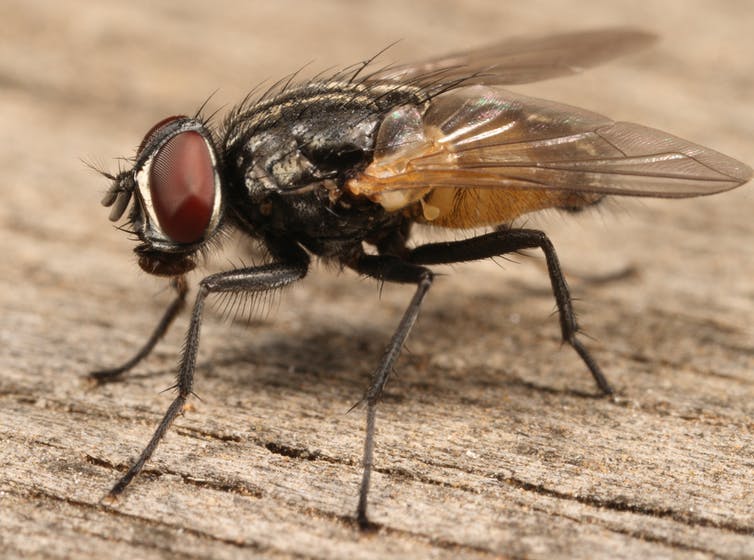BREAKING NEWS! America Study Confirms That House Flies Can Carry SARS-CoV-2 Virus Up To 24 hours After Exposure And Are Potential Vectors!
Source: House Flies Can Carry SARS-CoV-2 Virus Apr 26, 2021 4 years, 7 months, 1 day, 23 hours, 11 minutes ago
A new study by American researchers from Kansas State University and Agricultural Research Service have alarmingly found that
house flies can carry the SARS-CoV-2 coronavirus for up to 24 hours after exposure and are potential transmission vectors of the SARS-CoV-2 coronavirus!

House flies are known to transmit bacterial, parasitic and viral diseases to humans and animals as mechanical vectors. Previous studies have shown that house flies can mechanically transmit coronaviruses, such as turkey coronavirus; however, the house fly’s role in SARS-CoV-2 transmission was not explored until now. The goal of the study was to investigate the potential of house flies to mechanically transmit SARS-CoV-2.
Hence for this purpose, it was determined whether house flies can acquire SARS-CoV-2, harbor live virus and mechanically transmit the virus to naive substrates and surfaces.
Separate studies were performed to address the study objectives. In the first study, house flies were tested for infectivity after exposure to SARS-CoV-2-spiked medium or milk. In the second study, environmental samples were tested for infectivity after contact with SARS-CoV-2-exposed flies. During both studies, samples were collected at various time points post-exposure and evaluated by SARS-CoV-2-specific RT-qPCR and virus isolation.
It was alarmingly found that all flies exposed to SARS-CoV-2-spiked media or milk substrates were positive for viral RNA at 4 h and 24 h post-exposure. Infectious virus was isolated only from the flies exposed to virus-spiked milk but not from those exposed to virus-spiked medium. Moreover, viral RNA was detected in environmental samples after contact with SARS-CoV-2 exposed flies, although no infectious virus was recovered from these samples.
Under laboratory conditions, house flies acquired and harbored infectious SARS-CoV-2 for up to 24 h post-exposure. In addition, house flies were able to mechanically transmit SARS-CoV-2 genomic RNA to the surrounding environment up to 24 h post-exposure. Further studies are warranted to determine if house fly transmission occurs naturally and the potential public health implications of such events.
The studies were published in the peer reviewed journal:
Parasites & Vectors.
https://advances.sciencemag.org/content/early/2021/04/22/sciadv.abg7607
The SARS-CoV-2, the virus that causes the coronavirus disease (COVID-19), primarily spreads through respiratory droplets expelled when an infected person sneezes coughs or speaks.
It was also noted that in some instances, the droplets turn to aerosols and travel long distances or land on surfaces, leading to contact transmission.
The study team found that house flies can acquire and harbor infectious SARS-CoV-2 for up to 24 hours after exposure.
Alarmingly it was also found that house flies can mechanically transmit SARS-CoV-2 genomic RNA to the surrounding environment up to 24 hours post-exposure.
The study aimed to determine if house
fly transmission occurs naturally and the potential public health implications of such events.
Initially detected in Wuhan, China, in December 2019, SARS-CoV-2 is a novel coronavirus that has wreaked havoc across the globe. To date, more than 148 million people have been infected, and about 3.12 million have died globally.
The COVID-19 disease in humans is characterized by diverse disease outcomes, ranging from asymptomatic to mild or severe illness. The virus spreads primarily through respiratory droplets and aerosols. It can also spread through contact with contaminated fomites.
It has been known that house flies transmit bacterial, viral, and parasitic diseases to both humans and animals as mechanical vectors. They can carry over 250 different pathogens.
The SARS-CoV-2 coronavirus infects and replicates in the arthropod vector and is transmitted to hosts during feeding in biological transmission. During mechanical transmission, the virus is acquired internally or on external surfaces of the vector, like the wings, legs, and mouthparts.
It was reported that past evidence showed that they could mechanically transmit coronaviruses, like the turkey coronavirus. However, the role of house flies in SARS-CoV-2 transmission remains unknown.
The study found that house flies are capable of spreading infectious viruses within their immediate environment.
In summary, the two studies illustrated that
house flies are potential vectors of SARS-CoV-2. They can acquire, harbor, and transmit the infectious virus.
Under laboratory conditions, house flies acquired and harbored infectious SARS-CoV-2 for up to 24 hours post-exposure. Besides, house flies were able to mechanically transmit SARS-CoV-2 genomic RNA to the surrounding environment up to 24 hours post-exposure,” the researchers concluded in the study.
More urgent and detailed studies are required to determine if house fly transmission happens naturally and poses a global health threat.
It should also be noted that certain fact checkers who are not qualified to be scientific fact checkers in the first place had initially said that articles discussing the possibility of house flies transmitting SARS-CoV-2 was fake news. Since the publication of the study, may of these so called fact checkers have mainatained a low profile!
Please donate to help support our site and all our initiatives. https://www.thailandmedical.news/p/sponsorship
For more on
houseflies and coronaviruses, keep on logging to Thailand Medical News.
